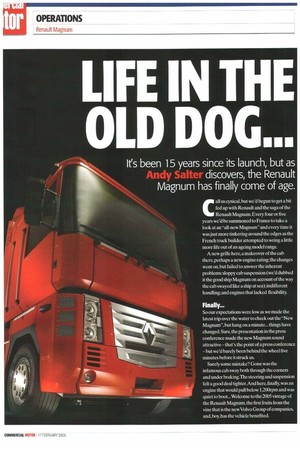I. FE tri THE OLD 1:10G...
Page 66

Page 67

If you've noticed an error in this article please click here to report it so we can fix it.
It's been 15 years since its launch, but as ruiuy aitainici discovers, the Renault
Magnum has finally come of age.
Call us cynical,but we'd begun to get a bit fed up with Renault and the saga of the Renault Magnum. Every four or five years we'd be summoned to France to take a look at an "all-new Magnum" and every time it was just more tinkering around the edges as the French truck builder attempted to wring a little more life out of an ageing model range.
Anew grille here,a makeover of the cab there, perhaps a new engine rating; the changes went on, but failed to answer the inherent problems: sloppy cab suspension (we'd dubbed it the good ship Magnum on account of the way the cab swayed like a ship at sea):indifferent handling; and engines that lacked flexibility.
Finally...
So our expectations were low as we made the latest trip over the water to check out the "New Magnum", but hang on a minute... things have changed. Sure, the presentation in the press conference made the new Magnum sound attractive that's the point of a press conference but we'd barely been behind the wheel five minutes before it struck us.
Surely some mistake? Gone was the infamous cab sway both through the corners and under braking.The steering and suspension felt a good deal tighter.And here,finally, was an engine that would pull below 1,200rpm and was quiet to boot...Welcome to the 2005 vintage of the Renault Magnum, the first fruits from the vine that is the new Volvo Group of companies, and,boy, has the vehicle benefited. The engineers have taken the best bit from Renault-the caband melded it with the best bits from their Swedish counterpart -the chassis and driveline.The result is a vehicle which combines the class leading ergonomics of the Magnum cab with the unrivalled ride,handling, braking and performance of the Volvo
Shared technology
Despite the shared componentry Renault has sought to retain its own identity with the Magnum, bizarrely going to lengths of never mentioning the V-word once throughout the whole of the launch.'The factory reps doggedly referred to a "group engine" and a "group gearbox" when it was plain for all to see that the engine was the 1312,12-litre lump from the Volvo FM and FU range and the transmission is the highly rated Volvo 1-Shift.
Granted the software might be slightly different,but the hardware certainly isn't and the Magnum is all the better for it.
Renault designates the 12-litre engine the DXi12. It's offered in two power ratings,440 and 480hp, with peak torque of 2,040 and 2240Nm respectively on tap from 1,050-1,450rpm. Sat behind the new power unit is a choice of manual or automatic transmissions.
The manual options remain unaltered from the outgoing range with ZF Ecosplit in direct drive or overdrive form as the standard offering. For a premium (and Renault won't announce UK pricing until the CV Show at the beginning of April) the new Magnum can be equipped with the 12-speed Optidriver II transmission.
This gearbox is Volvo's I-Shift by another name, with slightly different functionality For example, the gear lever is different to the Volvo's;Optidriver 11 also benefits from a new package called Optifuel.This function works on the top gear of the transmission and automatically increases engine performance by 200Nm within a specified range of engine speeds. Renault says this should avoid the need to change down on certain gradients, improving fuel consumption by up to 2% according to the type of use.
Completing the driveline is a choice of single or double reduction rear axles.
Elsewhere the Magnum benefits from a range of FH technology, with a new chassis offering a choice of two side-member heights and two amous cab sway through chassis thicknesses.A new front axle has
increased the wheel track, aiding
corners and under bra king liandling, while a new suspension set-up has addressed comfort issues Both 4x2 steering and suspension and 6x2 units will be available,though the latter won't be built until the autumn,which is a pity.
As before braking is handled by electronically controlled discs, though now the supplier is Knorr Bremse, which offers electronic stability control (ESP) as an option.Auxiliary retardation is well catered for by the high-performance Optibrake engine brake,but ZF orVoith retarders are available depending on transmission choice.






























































































































































































